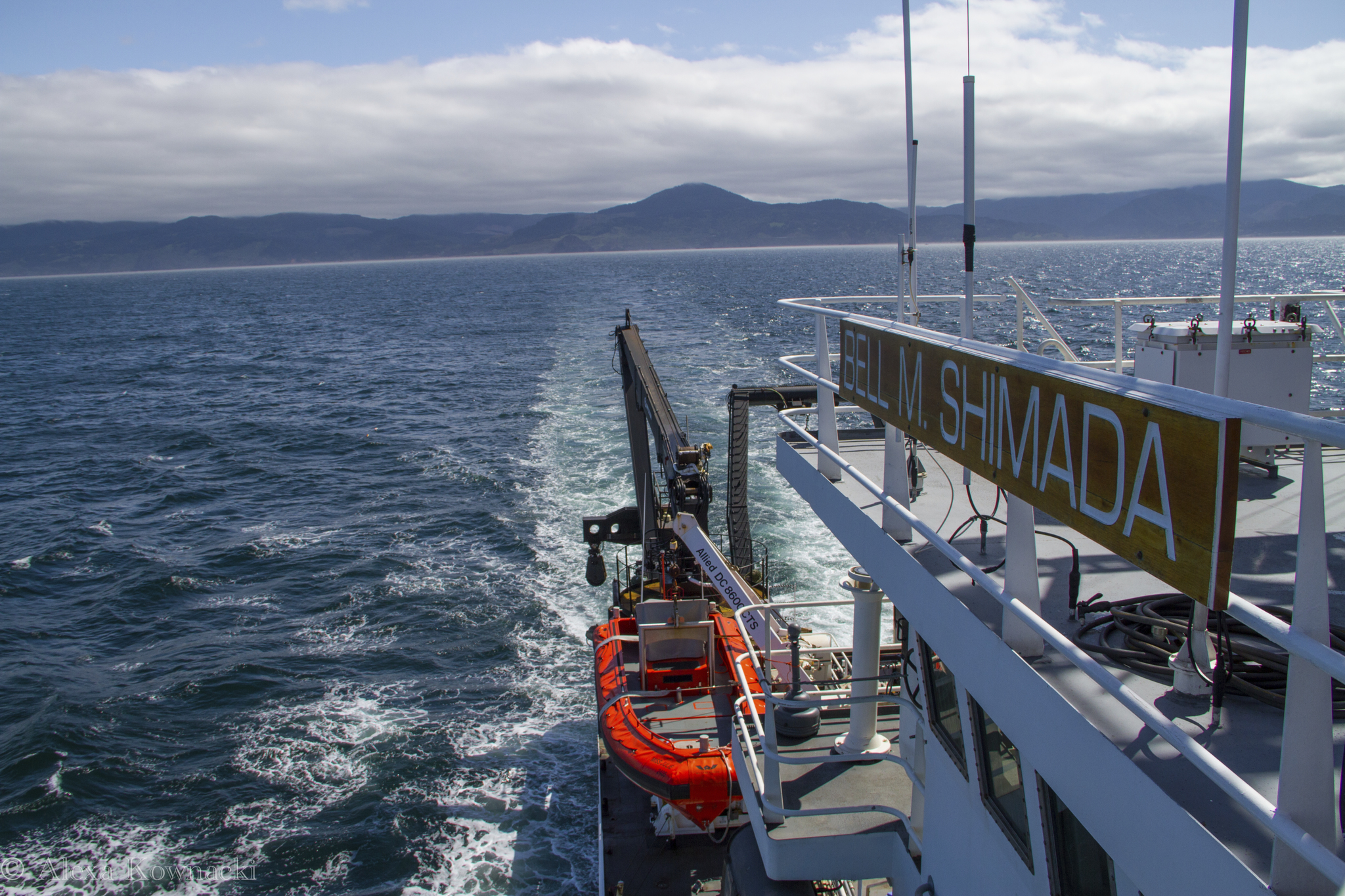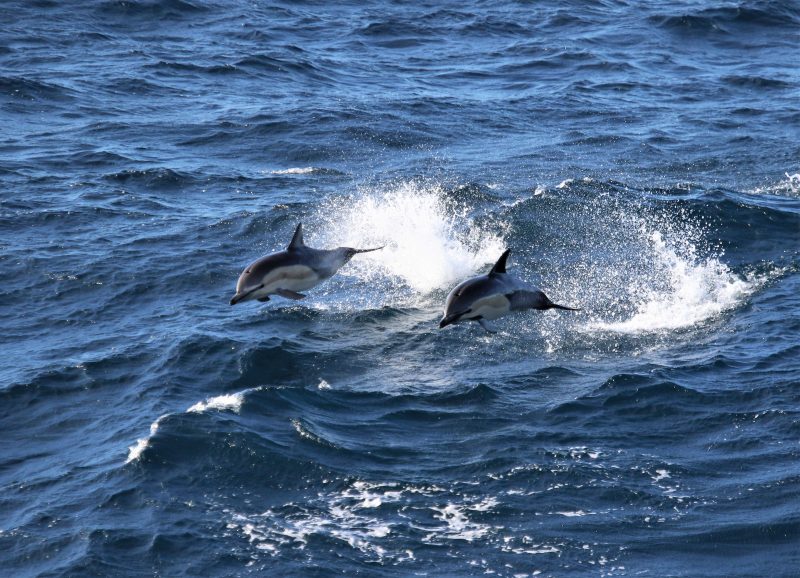By Lisa Hildebrand, MSc student, OSU Department of Fisheries and Wildlife, Geospatial Ecology of Marine Megafauna Lab
This past week has been very busy for me as I gave three quite important, yet very different, presentations. The first was on Tuesday at the Pacific High School in Port Orford, near my study site. The aim of the game was recruitment – my quest for two eager local high schoolers to be my interns for this 2019 summer field season has begun (read blogs written by our 2017 HS interns Nathan Malamud and Quince Nye)! I was lucky enough to be given an entire class period to talk to the students and so I hope that the picture I painted of kayaks, gray whales and sun will be enough to entice students to apply to the internship.
The second was a short presentation in one of the classes I took this term, GEOG 561: GIScience II Analysis and Applications. The class focuses on developing and conducting geospatial analyses in R and throughout the term each student develops a small independent research project using some of their own data. For my research project, I decided to do a small cluster analysis of the zooplankton community data that we have collected from the kayak net samples.
The third and final presentation of the week happened on Thursday and marked one of the big milestones on my Master’s journey: my research review. The research review is a mandatory (and extremely helpful) process in the Department of Fisheries & Wildlife where the student (in this case me), the committee (Dr Leigh Torres, Dr Rachael Orben, Dr Kim Bernard and Dr Susanne Brander) and a department representative (Dr Brian Sidlauskas) all assemble to discuss the student’s research proposal, which lays out the intended work, chapters, analysis and timeline for the students’ thesis. My proposal (which currently bears the title: “Tonight’s specials include mysids, gammarids and more: An examination of the zooplankton prey of Oregon gray whales and its impact on individual foraging patterns”) proposes a two-chapter thesis where the first examines the quality of zooplankton prey, while the second looks at potential individual foraging specialization of gray whales along the Oregon coast. While my entire committee agreed that what I have set forth to do in the next two or so years is ambitious, they provided me with excellent feedback and confidence that I would be able to achieve what I have planned.
Now that it’s the weekend and I’ve had some time to sit back and think about the week, I realized one major commonality between all three presentations I gave. None of the Powerpoints featured more than one image of a gray whale. How could this be?! It is after all my study species and I spend so much of my summer looking at them – how could it be that so little of what I showed and talked about was the thing that I am most passionate about and is so central to my research?
In the course of doing research, it’s easy to get wound up in the nitty gritty and forget about the big picture. While the nitty gritty is also imperative to conducting the research (and ultimately getting results), I sometimes forget about why I do what I do, which is that gray whales are AWESOME. Looking into the past, it seems that some of my lab mates have had the same realizations about their study species before too: see here and here. So for this blog, I want to bring it back to basics and share some of the things that I think are most fascinating about gray whales.
- Gray whales are the only baleen whale that feeds benthically. This behavior is facilitated by the shorter and tougher baleen that gray whales possess in comparison to other baleen whale species (Pivorunas 1979). The majority of the Eastern North Pacific (ENP) gray whale population feeds benthically in the Bering Sea where they eat ampeliscid amphipods, which are a type of benthic invertebrates (Nerini 1984). It is estimated that gray whales must regain 11-29% of critical body mass during the feeding season (Villegas-Amtmann et al. 2015) in order to obtain the energy stores they require for the entire year. Besides the personal benefit of sea floor foraging, by using this feeding tactic gray whales create depressions in the soft sediment that benefit other species besides themselves. The highly disruptive nature of this action can increase the biodiversity of the seafloor and initiate scavenging events by lysiannassid amphipods on other infauna (Oliver & Slattery 1985). Furthermore, Grebmeier & Harrison (1992) documented that a variety of seabirds including northern fulmars, black-legged kittiwakes and thick-billed murres feed on benthic amphipods brought to the surface by this unique foraging behavior performed by gray whales.
- Gray whales are essentially acrobats. A preference for benthic prey goes hand in hand with a preference for shallow, coastal waters, as for example Pacific Coast Feeding Group gray whales tend to forage within the 5-15 m depth range (Weller et al. 1999). With female adults ranging between 13-15 m in length (females tend to be slightly larger than adult males) and weighing anywhere between 15-33 tons (Jones et al. 1984), I am continuously fascinated by how gracefully and slowly gray whales can navigate extremely shallow waters.
However, it is more than just simple navigation – the behaviors and moves that some gray whales display while in the shallows is phenomenal too. Last year Torres et al. (2018) documented this agility through unmanned aerial systems (UAS) footage that provided evidence for some novel foraging tactics including headstands, side-swimming, and jaw snapping and flexing.
- They sure are resilient. Commercial whaling of gray whales began in 1846 after two commercial whaling vessels first discovered the winter breeding grounds in Baja California, Mexico (Henderson 1984). Following this discovery, the ENP were targeted for roughly a century before receiving full protection under the International Convention for the Regulation of Whaling in 1946 (Reeves 1984). Through genetic analyses, it has been estimated that the pre-whaling abundance of the ENP population was between 76,000 – 118,000 individuals (Alter et al. 2012), which is roughly three to five times larger than current estimates (24,000 – 26,000; Scordino et al. 2018). While the gray whale populations that once existed in the Atlantic Ocean were not as fortunate as those in the Pacific (Atlantic gray whales were declared extinct in the 18thcentury due to extensive whaling; Bryant 1995), the ENP has definitely made a strong comeback. Additionally, gray whale resilience is not only evident on this long temporal scale but it can also be seen annually when gray whale mothers fight relentlessly to keep their calves alive when under attack from killer whales. A study on predation of gray whales by transient killer whales in Alaska reported that attacks were quickly abandoned if calves were aggressively defended by their mothers or if gray whales succeeded in reaching depths of 3 m or less (Barrett-Lennard et al. 2011).
- For some unimaginable reason, gray whales appear to feel a strong connection to us. For many, gray whales might be best known for actively seeking out human contact during their breeding season in the Mexican lagoons. I find this actuality particularly interesting because of the bloody history we share with Pacific gray whales.
Those are just some of the things about gray whales that make them so fascinating to me. I look forward to potentially discovering one or two more things that we don’t know about them yet through my research. Even if that doesn’t turn out to be the case, I feel so lucky that I at least get to spend so much time with them during their feeding season here along the Oregon coast.
References
Alter, E.S., et al., Pre-whaling genetic diversity and population ecology in Eastern Pacific gray whales: Insights from ancient DNA and stable isotopes.PLoS ONE, 2012. doi.org/10.1371/journal.pone.0035039.
Barrett-Lennard, L.G., et al., Predation on gray whales and prolonged feeding on submerged carcasses by transient killer whales at Unimak Island, Alaska. Marine Ecology Progress Series, 2011. 421: 229-241.
Bryant, P.J., Dating remains of gray whales from the Eastern North Atlantic. Journal of Mammalogy, 1995. 76(3): 857-861.
Grebmeier, J.M., & Harrison, N.M., Seabird feeding on benthic amphipods facilitated by gray whale feeding activity in the northern Bering Sea. Marine Ecology Progress Series, 1992. 80: 125-133.
Henderson, D.A., Nineteenth century gray whaling: Grounds, catches and kills, practices and depletion of the whale population.Pages 159-186 inJones, M.L. et al., eds. The gray whale: Eschrichtius robustus, 1984. Academic Press, Orlando.
Jones, M.L., et al., The gray whale: Eschrichtius robustus. 1984. Academic Press, Orlando.
Nerini, M., A review of the gray whale feeding ecology. Pages 423-448 inJones, M.L. et al., eds. The gray whale: Eschrichtius robustus, 1984. Academic Press, Orlando.
Oliver, J.S., & Slattery, P.N., Destruction and obstruction on the sea floor: effects of gray whale feeding.Ecology, 1985. 66: 1965-1975.
Pivorunas, A., The feeding mechanisms of baleen whales.American Scientist, 1979. 67(4): 432-440.
Reeves, R.R., Modern commercial pelagic whaling for gray whales. Pages 187-200 inJones, M.L. et al., eds. The gray whale: Eschrichtius robustus, 1984. Academic Press, Orlando.
Scordino, J., et al., Report of gray whale implementation review coordination call on 5 December 2018.
Torres, L.G., et al., Drone up! Quantifying whale behavior from a new perspective improves observational capacity.Frontiers in Marine Science, 2018. 5: doi:10.3389/fmars.2018.00319.
Villegas-Amtmann, S., et al., A bioenergetics model to evaluate demographic consequences of disturbance in marine mammals applied to gray whales. Ecosphere, 2015. 6(10): 1-19.
Weller, D.W., et al., Gray whale (Eschrichtius robustus) off Sakhalin Island, Russia: Seasonal and annual patterns of occurrence. Marine Mammal Science, 1999. 15(4): 1208-1227.


















































































